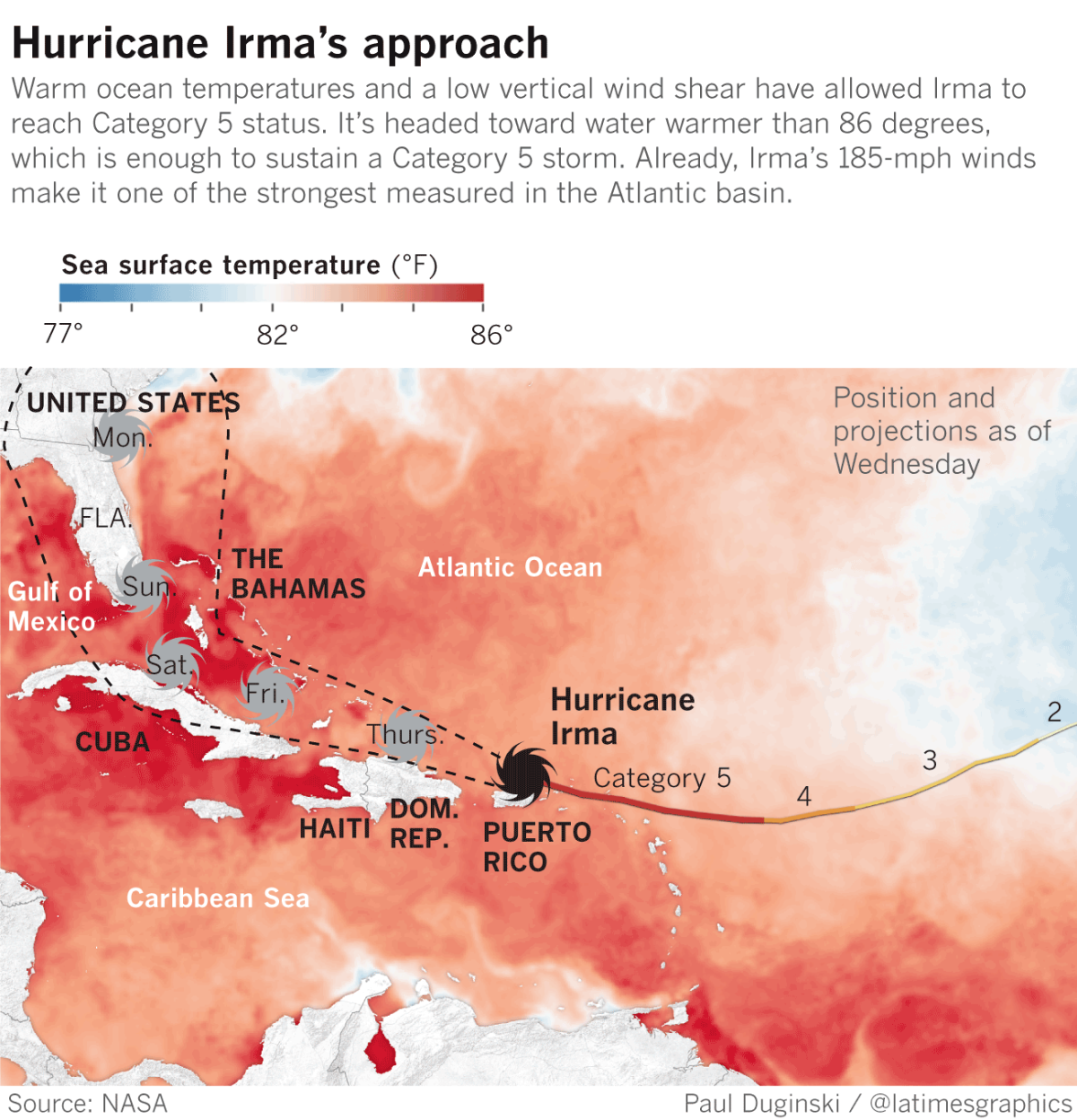Q&A: How Hurricane Irma became the second-strongest Atlantic hurricane on record

Speaking on French radio, France’s Interior Minister Gerard Collomb said the death toll in St. Martin and St. Barthelemy following Hurricane Irma could climb higher because rescue teams have yet to finish inspecting the islands.
- Share via
Hurricane Irma, a Category 5 storm, has already made history as one of the most powerful Atlantic hurricanes on record.
Unleashing 185-mph winds and torrential rainfall, Irma has already caused death and destruction on small islands in the Caribbean and is barreling toward major population centers. States of emergency have already been declared in Puerto Rico, the U.S. Virgin Islands, Florida and South Carolina.
Here is a breakdown on hurricane strengths and how Hurricane Irma gained power.
What does a Category 5 storm mean?
When meteorologists try to determine the strength of a hurricane and its potential damage to infrastructure, they rely on the Saffir-Simpson Hurricane Scale ranking. It is a scale, from 1 to 5, based on a hurricane’s sustained wind speed. Here are the categories and their potential for damage, according to the National Hurricane Center:
Category 1: Winds range from 74 mph to 95 mph, with the potential to uproot trees and damage roofs and power lines.
Category 2: Winds become “extremely dangerous,” reaching up to 110 mph. Damage to property is also much more likely and power outages are expected.
Category 3: Considered major storms, Category 3 hurricanes are likely to produce “devastating damage.” Wind speed could go up to 129 mph, resulting in damaged buildings and power outrages that could last for days.
Category 4: Wind speeds can go up to 156 mph. “Catastrophic damage” is expected in areas hit hardest. Hurricane Harvey was a category 4 storm when it struck Texas.
Category 5: Storms with winds of 157 mph or higher are ranked in this category. Hurricane Andrew, one of the most destructive hurricanes recorded, was a Category 5 storm that struck Florida in 1992, killing 25 people and destroying 28,000 homes.
What makes Hurricane Irma so powerful?
Hurricane season officially lasts from June 1 to Nov. 30, but the peak of the season, from mid-August to early September, is when strong hurricanes such as Irma typically occur.
There are certain ingredients needed to create a powerful hurricane.

Part of that perfect recipe includes warm ocean water and little wind shear— which refers to changing wind direction. For instance, the more strong winds change direction, the more they prevent a hurricane from organizing. Less change in wind direction allows the storm to brew and gain strength, according to John Brost, meteorologist with the National Weather Service.
A hurricane also gains strength when it passes over warm water in deep parts of the ocean, and waters have been warm this season.
Another reason for Hurricane Irma’s strength: Nothing has stood in its way to disrupt it, such as dry air, according to Brian Haus, a professor at the University of Miami’s Rosenstiel School of Marine and Atmospheric Science.
“When dry air comes into the storm, it impedes transfer of heat,” Haus said. Heat can allow a hurricane “to grow quickly and become powerful.”
The speed in which a hurricane travels also affects its intensity. Hurricane Irma is moving at around 16 mph, slow enough to utilize the energy it gets from the warm water and intensify before it hits land, Brost said.
How does Hurricane Irma compare to other storms?
With all those ingredients in place, Hurricane Irma’s winds have peaked at 185 mph, making it the second-strongest Atlantic hurricane on record. Hurricane Allen in 1980 was the strongest Atlantic hurricane, with winds reaching 190 mph.
Another indicator about how strong a hurricane can become is the pressure at the eye of the storm. The lower the pressure, the stronger the hurricane.
Hurricane Irma ranks at the 12th-lowest pressure of all time for hurricanes in the Atlantic Ocean, and Hurricane Allen ranked as fifth, said Brost. Hurricane Wilma in 2005 came in as No. 1 in terms of lowest pressure. Wilma, a Category 3, resulted in around $20 billion in damage.
ALSO
Four deaths reported as Hurricane Irma rakes Caribbean, with Florida likely in crosshairs
15 states, D.C. file lawsuit challenging Trump's DACA shutdown
Sign up for Essential California
The most important California stories and recommendations in your inbox every morning.
You may occasionally receive promotional content from the Los Angeles Times.








